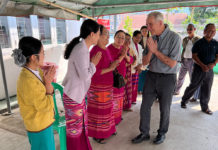One granny’s story
Editor: My personal experience with granny units has been an unqualified success. Several years ago, my husband, Roy, and I decided the vineyard and large family home we had built in 1978 on Mabee Lane was too much for us. Our children were grown and gone, and the labor was more intensive than we felt up to, so we applied for a permit to build a granny unit in the back yard of our 8,000 square foot rental property in town.
We did much of the work ourselves, with the valuable help of JR Arreguin, George Nieto, George Tamayo and Bill Howell, who contributed their specialties, and our neighbors, who helped with the grunt work. Healdsburg Lumber supplied most of the materials for the project.
The project was complicated by the clay-based soil on our property, which caused a tractor digging pipe trenches to wallow in the mud until we could pull it out with yet another tractor. Our tenants graciously tolerated the noise and disruption caused by the construction, and we finally moved into our tiny (750 square foot) house, which is perfect for a couple in their golden years. It has made it possible for us to age in place, while keeping the income from the rental to augment our pensions. We enjoy the frequent laughter of our neighbors’ children and our grandchildren, as they cavort and climb the mulberry tree rehabilitated last year by Mike Mahoney, in our common play yard.
My experience with Habitat for Humanity of Sonoma County, building the two houses on University Street, gave me additional impetus in the direction of alternative housing construction methods. As all labor is donated, and is an equity requirement for the prospective homeowners, it is possible to build a house at far lower cost than market rate. The Habitat supervisor is always a licensed contractor, and all work is inspected before anything is covered.
I encourage property owners who have the space to consider a secondary dwelling unit. It can provide a home for empty-nesters, while the main house can be made available to renters in or outside of the family. It can make it possible for your children to live in Healdsburg when it may otherwise be financially untenable.
Toni Saunders
Healdsburg
Ballot fatigue
Editor: I suspect Healdsburg voters will face ballot fatigue and vote no or not vote at all on an overwhelming majority if not all measures. We face 17 measures on the statewide ballot including several tax measures. a couple relative to ending the death penalty, legalization of marijuana, outlawing plastic bags, school construction bonds, prison inmate releases, restriction on adult film making and other nonsense.
Locally we have restrictions on genetically modified crops, restrictions on fluoride in our water, revision of a prior growth management initiative and more new taxes. One has to think just too much. I for one will vote no on everything.
When former Governor Hiram Johnson first proposed his progressive reforms – referendum, initiative and recall to combat the power of special Interests including the Southern Pacific Railroad, I don’t think he envisioned a ballot with over 20 measures on it. Now it is largely the special interests who are abusing the system and it’s time just to say no.
Kurt Hahn
Healdsburg
48.9
F
Healdsburg
April 20, 2025







